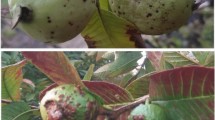Abstract
A PURE culture (isolate 1) of Pellicularia koleroga1 (Corticium koleroga) was isolated from the basidiospores found on Coffea arabica leaves, following well-known methods2. The fungus grew well on a number of agar media containing fresh extracts of potato, onion, carrot, oat, bean and malt, whereas its growth was very poor on a dextrose nitrate medium. However, when small quantities of malt, yeast, coffee leaf or fungal mat extracts were added to the dextrose nitrate medium, the fungus made good growth. A culture of this fungus obtained from the Centraal-bureau voor Schimmelcultures, Baarn, Holland, also behaved similarly, and its growth was even slower. It was therefore felt that Pellicularia koleroga may have certain growth-factor requirements.
Access this article
We’re sorry, something doesn't seem to be working properly.
Please try refreshing the page. If that doesn't work, please contact support so we can address the problem.
Similar content being viewed by others
References
Rogers, D. P., Farlowia, 1, No. 1 (1943).
Coleman, L. C., Venkata Rao, M. K., and Narasimhan, M. J., Mysore State Dept. Agric., Mycol. Ser., Bull. 5 (1923).
Robbins, W. J., and Kavanagh, V., Bot. Rev., 8 (1942).
Schopfer, W. H., “Plants and Vitamins” (Chronica Botanica Co., Waltham, Mass., 1943).
Author information
Authors and Affiliations
Rights and permissions
About this article
Cite this article
MATHEW, K. Growth-Factor Requirements of Pellicularia koleroga Cooke in Pure Culture. Nature 170, 889–890 (1952). https://doi.org/10.1038/170889b0
Issue Date:
DOI: https://doi.org/10.1038/170889b0
- Springer Nature Limited
This article is cited by
-
Nutritional regulation of basidiocarp formation and mycelial growth of Agaricales
Mycopathologia et Mycologia Applicata (1969)
-
Growth factor requirements ofPiricularia Spp. andSclerotium oryzæ
Proceedings / Indian Academy of Sciences (1958)
-
Studies on the black rot of coffee
Proceedings / Indian Academy of Sciences (1954)
-
Studies on the black rot of coffee
Proceedings / Indian Academy of Sciences (1954)
-
Thiamine, its intermediates and growth ofCorticium microsclerotia (Matz) Weber
Proceedings / Indian Academy of Sciences (1953)





